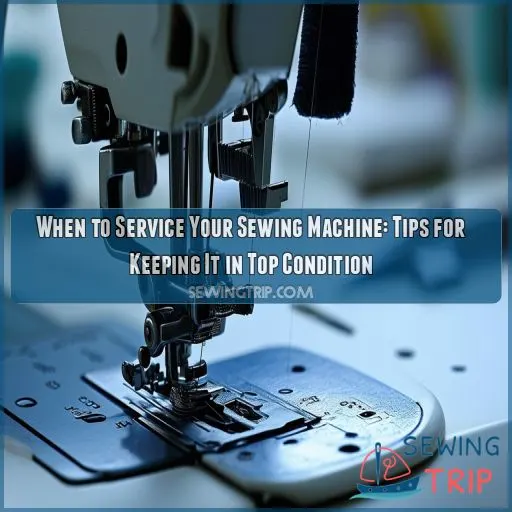This site is supported by our readers. We may earn a commission, at no cost to you, if you purchase through links.
 Is your trusty sewing machine starting to sound like a grumpy old cat? It is time to learn when to service your sewing machine.
Is your trusty sewing machine starting to sound like a grumpy old cat? It is time to learn when to service your sewing machine.
Regular maintenance keeps your machine purring along and ensures that stitches will be smooth while preventing costly repairs.
You will learn about the perfect service frequency, necessary cleaning steps, and how usage impacts maintenance needs.
We will cover age considerations, the importance of regular maintenance measures, and ways to listen for trouble.
Finally, we will conclude with a nod to general and effective servicing.
Now, get ready to keep your sewing companion in top condition for years.
Table Of Contents
- Key Takeaways
- When to Service Your Sewing Machine?
- Sewing Machine Service Frequency
- Importance of Basic Cleaning Steps
- Impact of Machine Use and Type on Servicing
- Significance of Regular Maintenance
- Considering the Age of Your Machine
- Listening to Your Machine for Service Clues
- Frequently Asked Questions (FAQs)
- Conclusion
Key Takeaways
- Listen to your machine like it’s your favorite pop star – those odd squeaks and grumbles are its way of saying "Hey, I need some TLC!" Regular tune-ups keep your trusty stitching sidekick purring along smoother than butter on a hot griddle.
- Think of servicing as a spa day for your sewing machine. For the workhorses putting in daily shifts, an annual professional pampering is just what the doctor ordered. Weekend warriors can stretch it to every 2-3 years, but don’t let your machine collect more dust than a forgotten attic!
- DIY maintenance is your secret weapon. A little lint-busting and oiling goes a long way – it’s like flossing for your machine! But remember, while you can freshen up its breath, leave the root canal to the pros.
- Age isn’t just a number for sewing machines. As your faithful friend enters its golden years, it might need more frequent check-ups. Think of it as the sewing equivalent of reading glasses and afternoon naps – perfectly normal, but requiring a bit more attention.
When to Service Your Sewing Machine?
You’ll need to service your sewing machine regularly to keep it humming along smoothly. Heavy users should schedule annual check-ups with a pro, while occasional sewists can service before big projects. Your machine’s workload and fabric choices impact servicing needs.
Basic maintenance includes removing lint, cleaning the bobbin area, and oiling moving parts. For daily use, aim for weekly TLC; occasional users can get by with twice-yearly attention.
Older machines may need more frequent care, so listen for unusual noises or stitch issues. By staying on top of maintenance, you’ll extend your machine’s life and avoid frustrating interruptions.
Curious about the nitty-gritty details of keeping your trusty stitcher in tip-top shape?
Sewing Machine Service Frequency
When you think about how often you should service your sewing machines, balance do-it-yourself maintenance with professional help. If you’re a heavy user of sewing machines, then annual servicing by a qualified technician will help to keep these machines in good working order.
Keeping the machine well-lubricated and using quality thread and fabric will prolong the life of the sewing machine. Besides, if your sewing machine is still under warranty, it may require professional servicing to maintain its warranty policy; refer to your warranty policy then.
In case you’re an occasional sewer, servicing the machine before each project will prevent problems. Service reminders in your watch; a tight hand wheel or erratic stitching will tell you. More heavily used machines or those used with heavy fabrics may require more frequent servicing.
Although you can certainly do some tasks of servicing yourself, like oiling and cleaning, DIY projects such as these do help extend the time between professional servicing but certainly don’t replace a sound technician’s eye on your machine.
Importance of Basic Cleaning Steps
Just a basic cleaning to keep your machine in top condition. Start by removing the lint build-up with a brush, as this could interfere with regular operation.
Open the bobbin compartment and clean out any lint, following the instructions in your manual. According to the manual, it’s pretty essential to do regular oiling to prevent wear.
You can do a more elaborate cleaning using a bit of compressed air, but be careful not to blow any lint into the machine’s internals. Weekly maintenance is needed for daily use, and occasional use for a cleaning every six months.
Clean the exterior of the machine with a soft cloth for that sparkle.
Impact of Machine Use and Type on Servicing
The frequency and type of use of your sewing machine will dramatically affect the servicing needs. For example, the use of heavier materials will impact tension and timing more than the use of lighter materials. For instance, patchwork quilting or decorative work produces significant amounts of lint and debris so that the machine may need more frequent cleaning. You’ll need to consider the following:
- Frequent Use: Yearly service to address wear.
- Infrequent Use: Service before the next project.
- Heavy duty applications: Check tension and timing frequently and make adjustments accordingly.
- Type of Fabric: Thicker materials require closer control.
Special Functions: Embroidery demands servicing in precision.
Significance of Regular Maintenance
Regular maintenance is the keystone of a smoothly-running sewing machine. It’s more than cleaning: it’s giving care and notice to every moving part.
Use a cleaning tool to brush off lint and dust from the top and extension table of your machine, and don’t forget to brush under the front part of the machine head area.
Ensure your machine is stored in optimal conditions to avoid rust and corrosion. Select the proper lubricant to keep parts moving freely—an operation that also helps prevent symptoms like skipped stitches and thread breakage.
An occasional service checklist, woven into your budget’s maintenance costs line item, can help avoid later frustration. Regular monitoring of sewing machine parts can uncover problems at their early stages.
Maintenance routines prolong the service life and reliability of your machine, allowing you to sew with confidence.
Considering the Age of Your Machine
Don’t overlook your sewing machine’s age when scheduling maintenance. Older machines may need more frequent lubrication and checking for part availability can help you plan future repairs.
Consider Machine’s Lifespan
First and foremost, consider the age of your machine. Older models frequently require more frequent lubrication and maintenance to ensure longevity.
Parts can become scarce—thereby increasing service costs. Check if your machine has any remaining warranty coverage.
More reliable brands usually have better support and parts supply for their machines, ensuring that this does all those intricate heirloom pieces efficiently.
Impact of Wear
Wear impacts skipped stitches, bobbin tension issues, needle breakage, thread breakage, and fabric snagging. Older machines often need more maintenance due to worn parts and frequent use. Pay attention to these issues as they signal service needs. Regularly inspect your machine to identify wear early, ensuring smooth operation, less frustration, and better sewing results.
Availability of Parts
Older machines at times face part unavailabilities. Discontinued models have hard-to-get components, resulting in high part cost replacement. Source parts through reputable suppliers or aftermarket choices. Regular maintenance helps, but knowing where to get those parts is essential for longevity.
Listening to Your Machine for Service Clues
To know when your sewing machine needs attention, listen for service indicators. Troubleshooting sounds is key. If you hear clanking, squeaking, or other unusual noises, it’s likely time for maintenance.
A tight handwheel suggests lubrication issues. Tension problems might indicate timing troubles or worn parts.
Regular maintenance routines, such as cleaning and oiling, can prevent these issues. Think of these noises as your machine’s way of asking for preventive measures. Ideally, you’d want to service it before it breaks down completely.
Frequently Asked Questions (FAQs)
How often should a sewing machine be serviced?
You should service your sewing machine annually if you use it frequently. For occasional users, service every 2-3 years. Listen to your machine; if it’s making unusual noises or experiencing tension issues, it’s time for a checkup.
Do you need to service a sewing machine?
Now, picture your faithful sewing machine jamming up in the middle of your work. You need to service your sewing machine regularly. This is necessary not just to maintain performance but also to avoid problems and ensure the lengthening of its life. Never wait until you’re faced with some issues; always be at the forefront regarding routine maintenance.
When should I lubricate my sewing machine?
You should lubricate your sewing machine regularly, typically after 8-10 hours of use. Don’t wait for squeaks or stiffness. Follow your machine’s manual for specific guidance, as some modern models require less frequent oiling than older ones.
What is the average lifespan of a sewing machine?
Imagine your trusty sewing companion, humming along for years. With proper care, you’ll enjoy 20-25 years of stitching bliss. Regular maintenance and timely repairs can extend your machine’s life, ensuring it’s ready whenever inspiration strikes.
Can I service my sewing machine myself?
You can also do some simple routine maintenance all by yourself. Clean the lint regularly, oil it when there’s a need to, and change the needles. Let other deep issues remain with the professionals. Annual servicing of your machine could help extend its life and ensure maximum performance by an expert.
How much does professional sewing machine servicing cost?
You’ll typically spend $50-$150 for professional sewing machine servicing. Costs vary based on your machine’s complexity and condition. Regular maintenance can reduce expenses. Some shops offer package deals for multiple services, potentially saving you money in the long run.
What tools are needed for basic machine maintenance?
Did you know 90% of sewing machine issues stem from poor maintenance? You’ll need a lint brush, screwdriver, tweezers, and machine oil. Don’t forget Compressed air for hard-to-reach areas. Regular upkeep keeps your machine humming smoothly.
Are computerized sewing machines harder to service?
Computerized sewing machines aren’t necessarily harder to service, but they require specific expertise. You’ll need a technician familiar with electronic components and software. Regular maintenance, like cleaning and oiling, remains similar to mechanical machines. Don’t attempt complex repairs yourself.
Should I oil my machine after every use?
You don’t need to oil your machine after each use. Just refer to your manual for guidance. Most of them only need oiling every 8-10 hours of sewing time. Regular cleaning is more important than frequent oiling.
Conclusion
Ultimately, what timing means to your servicing of the sewing machine will make all the difference in the life and functionality of your sewing machine.
With a regular maintenance schedule, basic cleaning, and feeling when your machine needs some attention, you’ll be able to keep it at its best.
Consider the age and usage rate of your machine when trying to determine how often it should be serviced.
A fine sewing machine is much like an instrument; treat it well, and it will reward you with years of smooth operation and beautiful stitches.
Open your ears and eyes to keep your loyal sewing companion in top condition.












